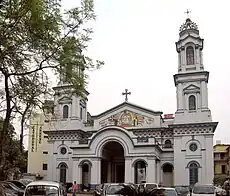Bengali Christians
Bengali Christians (Bengali: বাঙালি খ্রিস্টান) are adherents of Christianity among the Bengali people. Christianity took root in Bengal after the arrival of Portuguese voyagers in the 16th century. It witnessed further conversions among the Bengali upper-caste elite during the 19th century Bengali Renaissance.
বাঙালি খ্রিস্টান (Bangali Khrishtan) | |
|---|---|
| Total population | |
| 1,370,000 | |
| Regions with significant populations | |
| 640,000[1] | |
| 730,000 (West Bengal)[2] | |
| Languages | |
| Bengali (native), Hindi and English (secondary languages cum lingua francas for official purposes for those resident in India), Latin, Greek, Hebrew, Syriac (liturgical languages) | |
| Religion | |
| Christianity --- Catholicism --- Protestantism --- Indian Orthodox | |
| Related ethnic groups | |
| Bengali Muslims, Bengali Hindus, Bengali Buddhists | |
| Part of a series on |
| Christianity |
|---|
 |
| Part of a series on |
| Bengalis |
|---|
 |
Bengali Christians played significant role in Bengali culture, education, commerce and society. Some of the most influential thinkers and advocates during the Indian independence struggle from British Raj where Bengali Christians. The region is home to venerable missionary institutions, including the Missionaries of Charity founded by Mother Teresa.
History
Christianity was established in Bengal by the Portuguese missionaries in the 16th century. Basilica of the Holy Rosary, Bandel is the first church known to have been constructed in 1599 at Hugli-Chuchura in the Hooghly district of West Bengal, India. Another is known to have been established from the historical records was in Ishwaripore, Jessore (erstwhile Chandecan) in 1600 under patronage of Pratapaditya which later was ransacked.[3] Chittagong (erstwhile also referred to as Diang) with significant Portuguese and trading settlements had first hermitage and churches erected around this time. The Portuguese settlement in Chittagong hosted the first Vicar Apostolic in Bengal.[4] The Portuguese from there moved to Arakan, where they would transport Hindu and Muslim slaves, about 42,000 in number from 1621 to 1624, and converted 28,000 of those enslaved peoples to Christianity.[5] Jesuit missionaries also established churches in Bandel and Dhaka. In 1682, there were 14,120 Roman Catholics in Bengal.[1] William Carey translated the Bible into Bengali in 1809. Many upper-class Bengalis in the British Indian capital Calcutta converted to Christianity during the Bengal Renaissance.
The Missionaries of Charity, founded by the Mother Teresa in Calcutta in 1950 played a major role in supporting and sheltering refugees during the Bangladesh Liberation War in 1971.
Denominations
Roman Catholic Church
The Catholic Church in Bangladesh is based in the Archdiocese of Dhaka, with dioceses in Dinajpur, Mymensingh, Sylhet and Rajshahi and Archdiocese of Chittagong, with dioceses on Barisal and Khulna .[6]
- Province of Dhaka: Metropolitan Archdiocese of Dhaka
- Province of Chittagong: Metropolitan Archdiocese of Chittagong
The Roman Catholic Church in West Bengal is based in the Archdiocese of Calcutta.
Anglican Communion
There are three dioceses of the Anglican Church of Bangladesh:
St. Paul's Cathedral, Kolkata is the seat of the Anglican Diocese of Calcutta (1813) of the Church of North India (CNI).
- Diocese of Barrackpore
- Diocese of Durgapur
- Diocese of Calcutta
Other denominations
Other denominations include:[6]
- Assemblies of God in India
- India Pentecostal Church of God
- The Pentecostal Mission
- Armenian Apostolic Church
- Bengal Orissa Bihar Baptist Convention
- Brethren in Christ Church
- Church of God (Anderson)
- El Shaddai
- New Life Fellowship Association
- Bangladesh Baptist Church Sangha (BBCS)
- Isa-e Church (Bangladesh)
Demographics
Bengali Christians are considered a model minority in South Asia and usually enjoy a high literacy rate, low male-female sex ratio and a better socio-economic status.[7] Christian missionaries operate many schools, hospitals and shelters for the poor. They receive support from the Indian and Bangladeshi governments.
Dhaka, Chittagong, Barisal, Khulna and Northern District Side have significant Christian populations.
Culture
Lusophone heritage
Some Catholic Bengali Christians have Portuguese surnames. In a tradition similar to Bengali Muslims (who have Arabic and Persian names), Bengali Christians adopted Portuguese surnames due to the early influence of Portuguese missionaries in spreading Christianity. Common Catholic Bengali Christian surnames include Gomes, Rozario, D'Costa, Gonsalvez, Cruze, Dias, D'Silva and D'Souza among others.[8]
Christmas is known as "Boro Din" (Big Day) and is a public holiday in both Bangladesh and Indian West Bengal.
Notable people
Politicians
- Gloria Jharna Sarker, Bangladesh's first Christian Woman MP (2019)
References
- Luchesi, Brigitte (1999), "Bangladesh", in Fahlbusch, Erwin, Encyclopedia of Christianity 1, Grand Rapids: Wm. B. Eerdmans, pp. 182–183, ISBN 0802824137
- "Archived copy" (PDF). Archived from the original (PDF) on 2011-07-20. Retrieved 2015-08-01.
{{cite web}}: CS1 maint: archived copy as title (link) - Ray, Aniruddha (1976). "Case Study of a Revolt in Medieval Bengal: Raja Pratapaditya Guha Roy". In De, Barun (ed.). Essays in Honour of Prof. S.C. Sarkar. Delhi: People's Pub. House
- "Chronicle/Snippets". Archived from the original on 2020-02-12. Retrieved 2015-08-01.
- Ahmed, S.M. Tanveer Ahmed. Christian Missions in East Bengal.
- World Christian Encyclopedia, Second edition, 2001 Volume 1, p. 368-371
- "Indian Christians Treat Their Women Better, Sex Ratio Highest". 25 December 2007. Archived from the original on 3 July 2017. Retrieved 1 August 2015.
- "Você fala Bangla?". Dhaka Tribune. 25 January 2014. Archived from the original on 21 June 2015. Retrieved 4 August 2015.


